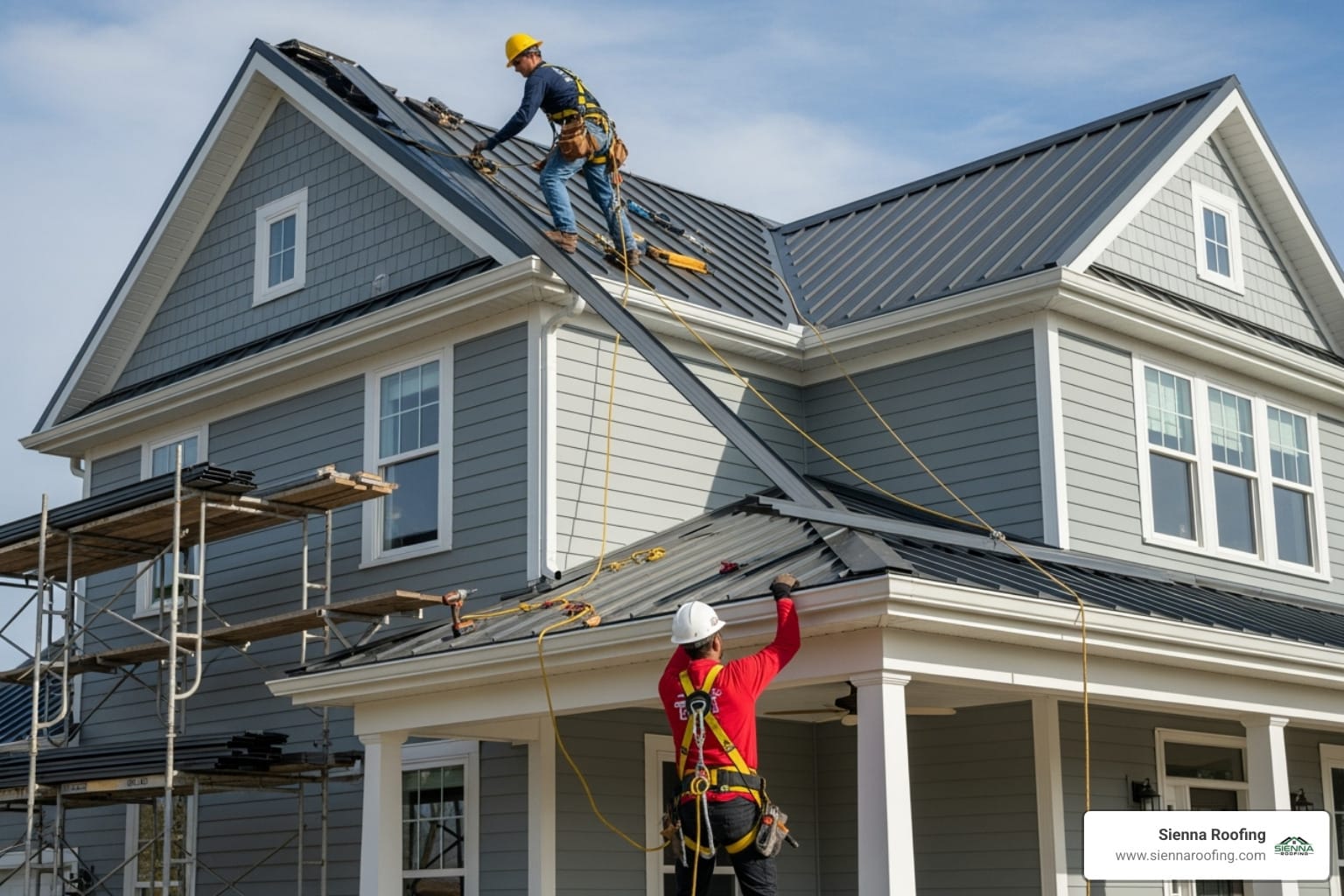Average cost to tear off and replace roof with metal 2025!
Why Understanding Metal Roof Replacement Costs Matters for Texas Homeowners
For homeowners in Texas, a roof is more than just a covering; it’s the first line of defense against everything from blistering summer heat and torrential downpours to hurricane-force winds and damaging hail. When it’s time for a replacement, the decision you make has long-term consequences for your home’s safety, value, and energy consumption. The average cost to tear off and replace roof with metal ranges from $6,800 to $51,000, with most homeowners spending around $14,039 for a standard 1,700-square-foot roof. For Sugar Land homeowners considering a high-quality metal roofing upgrade, understanding these costs is the first step toward a smart, long-term investment.
While the initial price tag is higher than traditional asphalt shingles, the value proposition of metal roofing becomes clear when you consider its lifespan. A properly installed metal roof can last 40, 50, or even 70+ years, far outliving the typical 15-30 year lifespan of asphalt shingles. This means you could replace an asphalt roof two or even three times in the same period you would have a single, reliable metal roof. This durability makes it an exceptionally cost-effective choice over the life of your home.
Quick Cost Breakdown (1,700 sq. ft. roof):
- Aluminum: $6,800-$18,700
- Steel: $11,900-$20,400
- Standing Seam: $15,300-$27,200
- Copper: $25,500-$51,000
- Labor: 50-60% of total cost
- Tear-off: $1-$3 per square foot additional
Texas weather is notoriously tough. The intense UV radiation breaks down materials, hail storms can pulverize lesser roofs, and high humidity along the Gulf Coast promotes rust and algae growth. Metal roofing is engineered to combat these challenges, delivering superior protection and added benefits like enhanced energy efficiency that can significantly lower your summer cooling bills. I’m Andre Castro, CEO of Sienna Roofing. With a Construction Management degree from Texas A&M and over five years dedicated to the roofing industry, I’ve personally guided countless homeowners in the Houston area through their roofing decisions. My team and I are committed to ensuring every project meets the highest standards of quality and craftsmanship, all backed by transparent pricing and clear communication from start to finish.
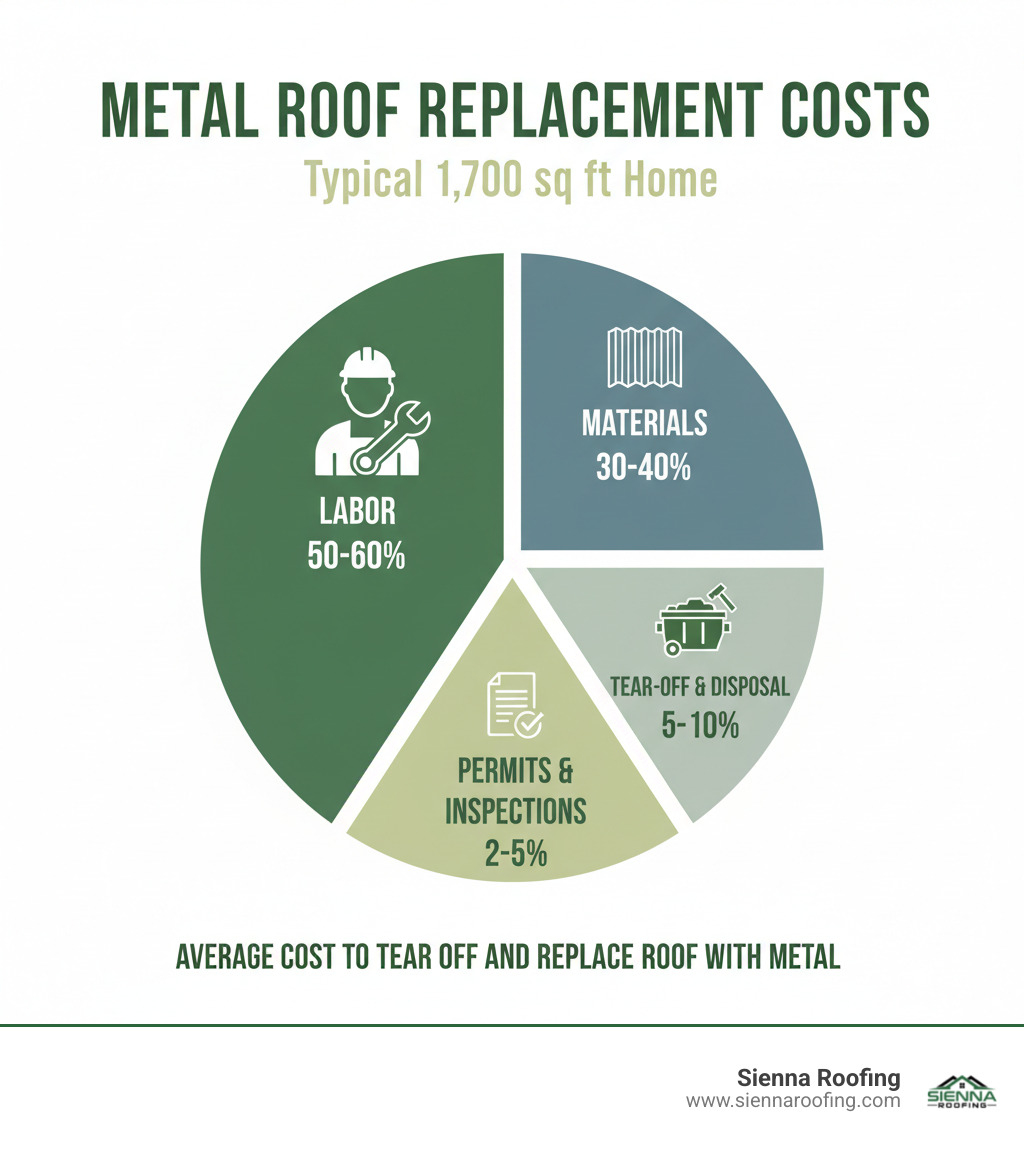
Average cost to tear off and replace roof with metal terms to remember:
Breaking Down the Numbers: The Average Cost to Tear Off and Replace a Roof with Metal
Let’s get straight to the numbers that matter. The average cost to tear off and replace roof with metal is around $11,741 nationwide, but this figure can be misleading without context. Most homeowners will spend between $5,740 and $17,753. For a typical 1,700-square-foot home in the Houston area, the average is about $14,039, with a common range of $10,940 to $16,722. This variation is due to material choice, roof complexity, and labor rates.
The cost per square foot for a metal roofing system, including installation, spans a wide range from $4 to $30. This means a 1,700-square-foot roof could cost anywhere from $6,800 for a basic aluminum shingle profile to a staggering $51,000 for a premium copper standing seam roof. In Texas, where durability is paramount, metal roof replacements average around $20,300. While this is a significant investment compared to the average asphalt roof replacement cost of $9,700, the long-term value is undeniable. With a 40+ year lifespan versus asphalt’s 20 years in the harsh Texas sun, a metal roof is an investment in permanence. For more details, explore our metal roofing services, where we outline our comprehensive installation process.
Here’s a more detailed cost breakdown for a 1,700 sq. ft. roof:
| Metal Type | Average Cost Per Square Foot | Estimated Total Cost for 1,700 sq. ft. |
|---|---|---|
| Aluminum | $4 – $11 | $6,800 – $18,700 |
| Galvanized Steel | $7 – $12 | $11,900 – $20,400 |
| Standing Seam | $9 – $16 | $15,300 – $27,200 |
| Zinc | $6 – $12 | $10,200 – $20,400 |
| Copper | $15 – $30 | $25,500 – $51,000 |
Metal Roof Cost by Type: From Steel to Copper
Choosing a metal roofing material is like picking a vehicle—options range from a practical, reliable sedan to a high-performance luxury sports car. Each has its place, depending on your budget, performance needs, and aesthetic goals.
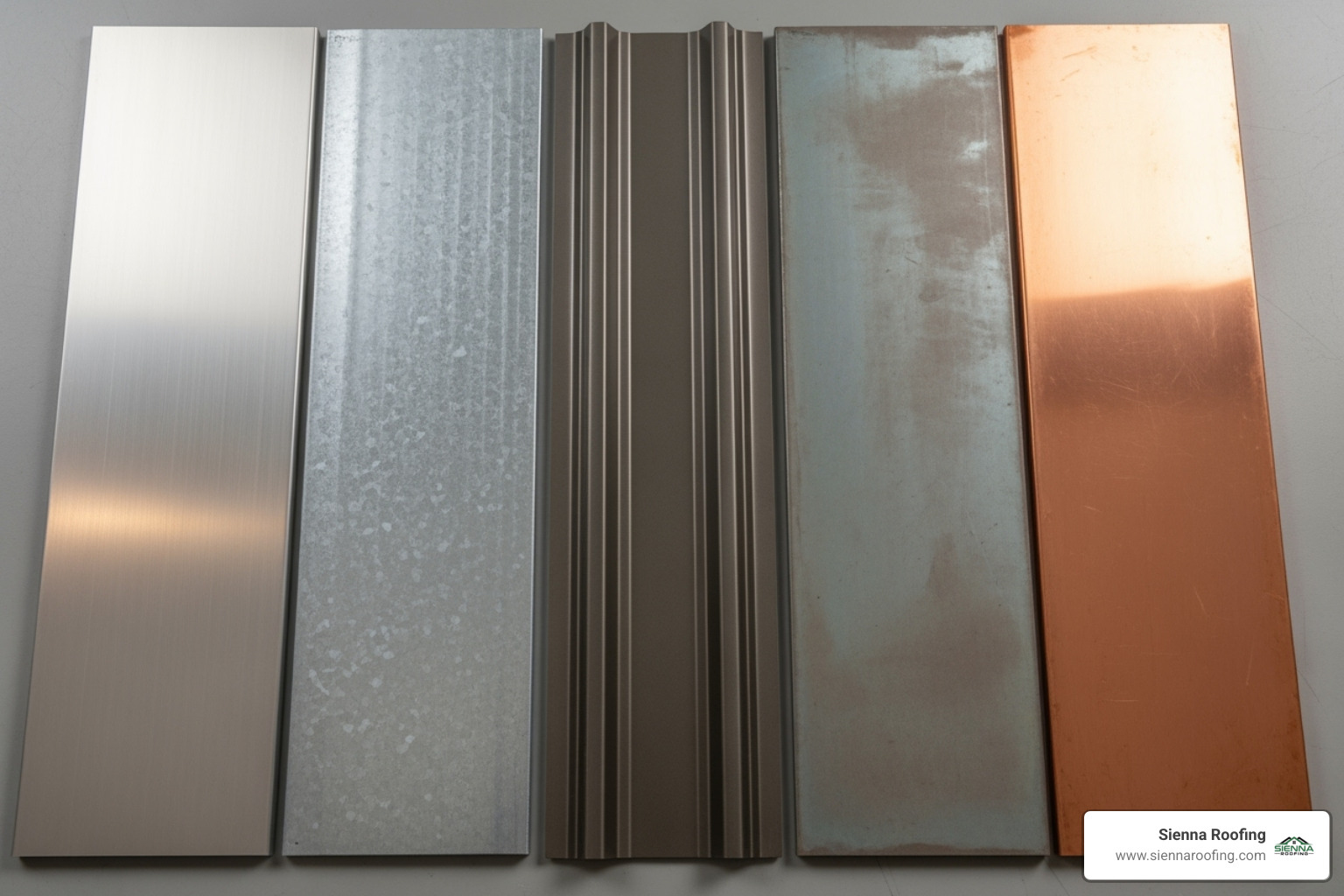
- Aluminum ($4-$11/sq ft): Lightweight, highly corrosion-resistant, and surprisingly strong. It’s an ideal choice for coastal Texas homes due to its resistance to salt spray. It won’t rust, and it lasts nearly 50 years.
- Galvanized Steel ($7-$12/sq ft): The workhorse of the metal roofing world. It’s a steel core coated with zinc (galvanized) or an aluminum-zinc alloy (Galvalume) to prevent rust. It is incredibly durable, impact-resistant, and can last up to 100 years with proper maintenance, making it a popular choice for its balance of strength and cost.
- Standing Seam ($9-$24.50/sq ft): This is a premium roofing system, not just a material. It features vertical panels joined by raised, interlocking seams with concealed fasteners. This design eliminates thousands of screw holes, which are potential leak points, and allows for thermal expansion and contraction. It offers a sleek, modern aesthetic and 50+ years of worry-free performance.
- Zinc ($6-$12/sq ft): A remarkable, long-lasting material that is essentially self-healing. Its protective patina reforms over time, effectively erasing minor scratches. It offers 100+ years of protection with minimal maintenance and is 100% recyclable, making it a favorite for architecturally significant and eco-conscious projects.
- Copper ($15-$30/sq ft): The ultimate luxury option. Copper is the most durable roofing material available, lasting well over 100 years. It requires no painting or coating and develops a beautiful, characteristic blue-green patina over time that is prized for its elegance. It is the pinnacle of roofing craftsmanship and longevity.
The Average Cost to Tear Off and Replace a Roof with Metal Shingles vs. Panels
Your choice of style—the profile of the metal—affects both the final cost and your home’s curb appeal.
- Metal Shingles ($7-$22/sq ft): These products mimic the look of traditional asphalt shingles, slate, or wood shakes, but with the superior performance of metal. They are an excellent choice for homeowners who want the benefits of metal while adhering to strict HOA guidelines or preserving a classic architectural style.
- Standing Seam Panels ($9-$24.50/sq ft): As mentioned, this system’s vertical seams create an incredibly weather-tight barrier. Installation is a craft that requires specialized tools and skills to manage panel alignment, flashing details, and seam locking. This complexity adds to the labor cost, but the result is a roof engineered to withstand the most severe Texas storms.
- Corrugated Panels ($3.50-$15/sq ft): This is a budget-friendly option with a distinctive wavy pattern, often associated with agricultural or commercial buildings but gaining popularity in modern residential design. The panels are attached with an exposed fastener system (screws with rubber washers). While cost-effective, this system requires periodic maintenance, as the screws may need to be checked and replaced every 7-10 years to prevent leaks.
The installation complexity varies greatly between these styles, with standing seam being the most demanding and corrugated panels being the most straightforward. This difference directly impacts the labor portion of your final cost. To better understand your options, check out our guide on different roofing materials.
Beyond the Price Tag: Key Factors That Influence Your Metal Roof Replacement Cost
Understanding the average cost to tear off and replace roof with metal requires looking beyond the price of the materials themselves. A final quote is a composite of many variables. At Sienna Roofing, we believe in total transparency, so let’s break down the key factors that influence your final investment in detail.
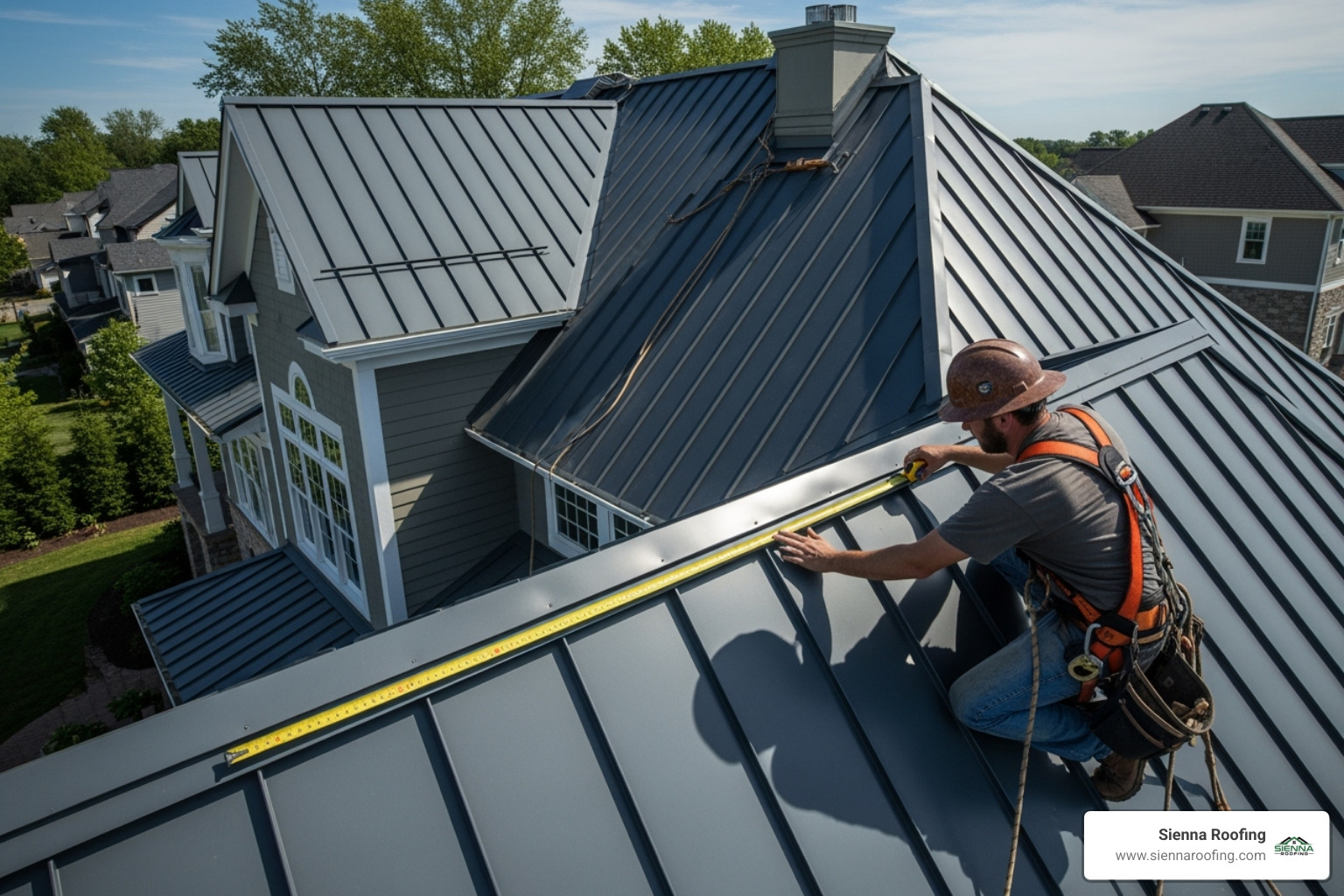
Several key elements determine your project’s total cost. Roof size is the most obvious—a larger roof requires more materials and more labor hours. However, roof pitch (its steepness) and complexity (the number of dormers, skylights, chimneys, valleys, and hips) also play significant roles. Each of these features interrupts the straight runs of panels or shingles, requiring custom cutting, intricate flashing, and precision sealing to ensure a watertight finish. This specialized work adds time and material waste, increasing the overall cost. Other critical factors include the cost of labor, the tear-off and disposal of the old roof, local permits, and the installation of a high-quality underlayment, which acts as a secondary barrier against moisture.
Labor and Tear-Off: The Hidden Costs
Labor is the single largest component of a metal roof replacement, typically accounting for 50% to 60% of the total project cost. This is because metal roofing installation is a specialized skill. It is not the same as installing asphalt shingles. A metal roof can take two to three times longer to install correctly, requiring a crew with specific training, tools, and experience. This higher labor expense is an investment in a leak-free, long-lasting installation.
The tear-off process adds another $1 to $3 per square foot to the project. This cost covers the labor to remove the old roofing material and the fees for proper debris disposal. If your home has multiple layers of old shingles (a common shortcut from previous roofers), each additional layer can add another $1 to $2 per square foot for removal. The disposal cost includes dumpster rentals, which typically range from $220 to $699 per week, depending on size.
We always recommend a full tear-off. This allows us to perform a thorough inspection of the roof decking (the wooden sheathing underneath). We check for rot, water damage, or structural weakness. Placing a brand-new, 50-year metal roof on a compromised foundation is a recipe for disaster. A full tear-off ensures a stable, solid base and prevents future moisture issues. Learn more in our complete roof replacement guide.
How Roof Size, Pitch, and Complexity Affect the Price
Roof size is measured in “roofing squares,” where one square equals 100 square feet. It’s important to note that your roof’s square footage is almost always greater than your home’s square footage due to the roof’s pitch and any overhangs.
Roof pitch directly impacts labor costs. A low-slope, walkable roof is relatively straightforward. However, once a roof’s pitch becomes steeper than a 6:12 ratio (a 6-inch vertical rise for every 12 inches of horizontal run), it is considered a “steep-slope” roof. Working on these roofs requires additional safety equipment, such as harnesses and roof jacks, and the installation process is slower and more methodical, driving up labor costs.
Roof complexity is a major price driver. A simple rectangular gable roof is the most cost-effective to replace. As you add architectural features, the cost increases. Each gable, valley, dormer, skylight, or chimney requires meticulous, time-consuming labor. For example, a valley requires a special channel to be installed, and every panel meeting that valley must be cut at a precise angle. A chimney requires four different types of flashing (front, side, and a back cricket) to be custom-fabricated and sealed. These details increase labor time, material waste from custom cuts, and the need for a highly skilled installer. That’s why an accurate, on-site assessment is crucial. Learn about our process to get a precise roof replacement estimate.
Understanding the Average Cost to Tear Off and Replace a Roof with Metal in Texas
Texas is a unique market, and several local factors influence the average cost to tear off and replace roof with metal.
- Local Labor Rates: The Houston metropolitan area, including Sugar Land and Missouri City, has a competitive market with a deep pool of skilled craftsmen who understand the specific demands of Texas roofing. We focus on maintaining fair pricing while paying our expert crews a wage that reflects their high level of skill, ensuring quality work on every job.
- Material Availability: Our proximity to major distribution hubs and ports in Houston helps keep material transportation costs reasonable. We have long-standing relationships with trusted local and national suppliers, allowing us to secure competitive prices on top-quality materials.
- Permitting Costs: Municipalities have their own fee structures. In Sugar Land, for example, building permits for a roof replacement typically range from $100 to $1,000. These permits are non-negotiable and ensure your new roof is installed to meet local safety and building codes, which is a crucial protection for the homeowner.
- Climate Considerations: Our region’s intense heat, high humidity, and risk of hail and hurricanes directly influence our recommendations. We often suggest thicker gauge steel (e.g., 24-gauge instead of 26-gauge) for superior hail resistance. For homes closer to the coast, we recommend aluminum or Galvalume-coated steel for its superior corrosion resistance. These climate-specific choices ensure your roof is built to last in our demanding environment.
Understanding these local factors is key to providing accurate, comprehensive estimates for Texas homeowners. For more state-specific insights, visit: What is the average cost of a new roof in Texas?.
Is a Metal Roof Worth It? Weighing the Pros, Cons, and Long-Term Value
When you first see the average cost to tear off and replace roof with metal, it’s natural to experience some sticker shock. However, framing a metal roof as a simple expense is a mistake. It’s a capital investment in your home’s infrastructure, one that pays dividends in protection, savings, and peace of mind for decades to come.
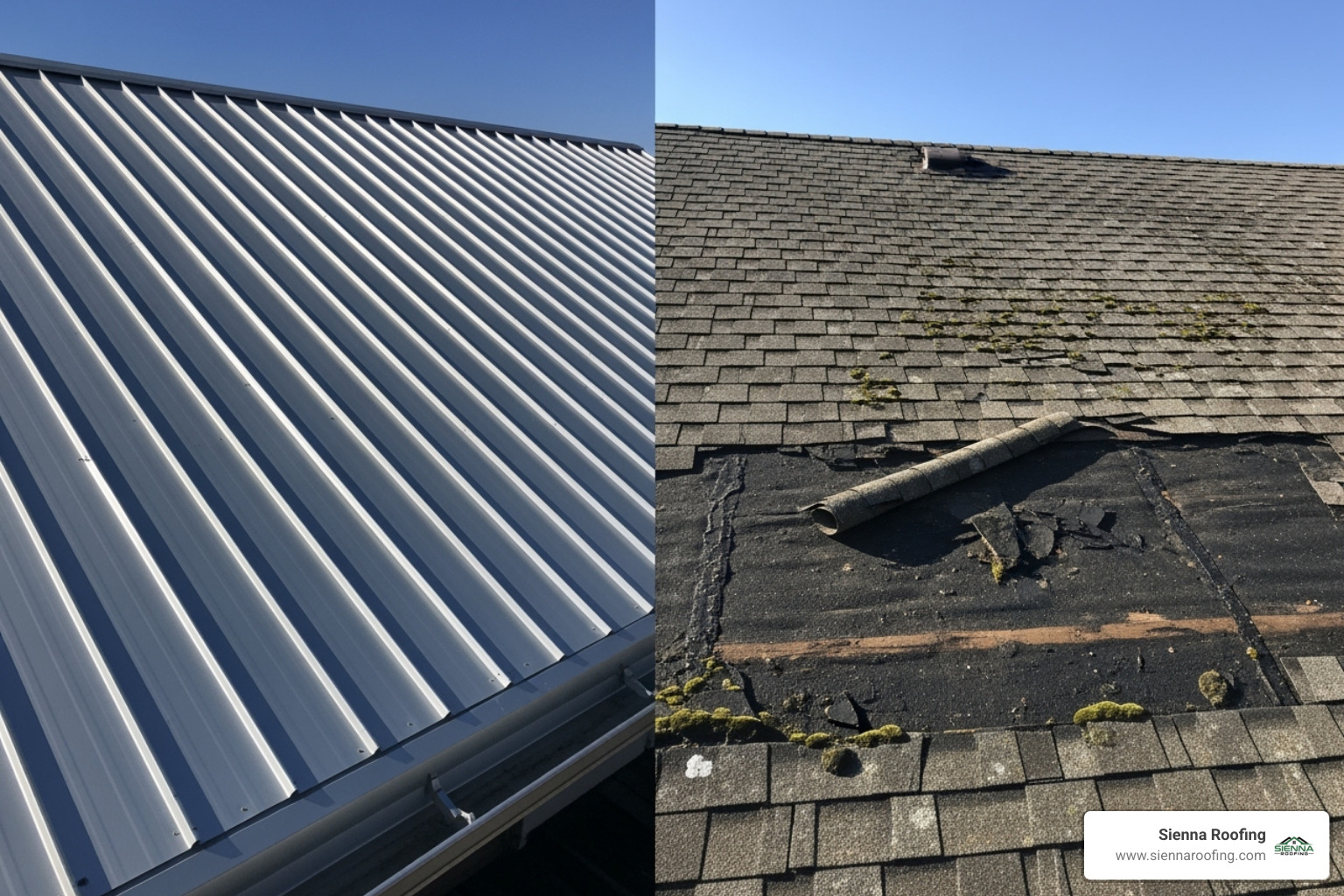
The chart above illustrates the core value proposition. In the time a single metal roof protects your home, you might pay for the materials, labor, and tear-off of an asphalt roof two, or even three, times over. A quality metal roof installed today could very well be the last roof you ever need to buy for your home. That’s not just a matter of convenience—it’s a powerful financial calculation that saves you from future replacement costs, inflation, and the stress of repeated major construction projects.
Advantages: Why Homeowners Choose Metal
The benefits of metal roofing are particularly compelling for homeowners in Texas, where our weather constantly tests a building’s envelope.
- Exceptional Lifespan: This is the primary advantage. Metal roofs last 40-70 years on average. Premium materials like copper and zinc can last over 100 years. In contrast, asphalt shingles, especially in the intense Texas sun, have a realistic lifespan of only 15-30 years.
- Superior Durability & Weather Resistance: Metal roofs are engineered to perform. They can withstand sustained winds up to 140 mph (some systems are rated even higher), making them ideal for hurricane-prone regions. They resist cracking, rotting, and warping. While very large hail can cause cosmetic dents, they are far more impact-resistant than asphalt or clay tile. Many metal roofing products carry a Class 4 impact resistance rating, the highest available.
- Energy Efficiency: Metal roofs reflect a significant amount of solar heat, which can reduce home cooling costs by 10-25%. This is a massive benefit in a climate where air conditioning runs for months on end. “Cool roof” pigments can re-emit up to 90% of absorbed solar radiation, keeping your attic and home cooler.
- Fire Resistance: Metal is a non-combustible material and typically carries a Class A fire rating, the highest possible. This provides critical protection against airborne embers from nearby fires and offers invaluable peace of mind.
- Eco-Friendly: Metal roofing is a sustainable choice. Many metal roofs contain 30-60% recycled content, and at the end of their long life, they are 100% recyclable. This stands in stark contrast to asphalt shingles, which contribute millions of tons of non-recyclable waste to landfills each year.
- Low Maintenance: A properly installed metal roof requires very little upkeep. We recommend an annual inspection to check flashings and ensure no debris has accumulated, but there is no need for the constant repair and replacement of shingles that other roof types require.
Disadvantages and Considerations
Transparency is key, and every material has potential drawbacks. It’s important to be aware of them.
- Higher Upfront Cost: There’s no getting around it—the initial investment for a metal roof is significantly more than for asphalt shingles, often two to three times the price.
- Potential for Denting: While durable, thinner gauge metals can be dented by extremely large hail or falling tree limbs. This risk can be mitigated by choosing a thicker gauge (e.g., 24-gauge vs. 29-gauge) or a metal profile with texturing (stucco-embossed) that helps to hide minor imperfections.
- Installation Complexity: This is not a DIY project. Proper installation requires a specialized roofing contractor with experience in metal systems. Improper installation can lead to leaks and negate the roof’s longevity.
- Repair Costs: While repairs are infrequent, they can be more complex and expensive than patching an asphalt shingle. A skilled metalworker is needed to properly replace a damaged panel or repair a seam.
Calculating Your Return on Investment (ROI)
Despite the higher initial cost, the long-term financials often favor metal roofing. Consider this hypothetical 50-year scenario for a $15,000 metal roof vs. a $7,500 asphalt roof. The metal roof is a one-time cost. The asphalt roof will likely need to be replaced at year 20 and year 40. Assuming a modest 3% annual inflation, the second roof would cost over $13,500, and the third would cost over $24,000. The total 50-year cost for asphalt would be over $45,000, compared to $15,000 for metal, not even counting energy savings.
- Home Resale Value: A metal roof is a powerful selling feature. The 2024 Cost vs. Value Report for the West South Central region shows that a metal roof replacement offers a 48.1% return on investment at resale.
- Insurance Discounts: Many insurance companies offer discounts for homes with Class 4 impact-resistant or Class A fire-rated metal roofs. Check with your provider.
- Energy Savings: Saving 10-25% on cooling costs can add up to thousands of dollars over the life of the roof.
- Reduced Replacement Frequency: Avoiding the cost and disruption of one or two future roof replacements provides substantial and predictable long-term savings.
A metal roof often pays for itself over time through this combination of energy savings, increased home value, and eliminated replacement costs.
Finding a Local Metal Roofing Expert in Sugar Land, TX
When you’re ready to make a significant investment in a metal roof, finding the right contractor is the single most important decision you will make. A premium roofing system is only as good as its installation. A flawless installation ensures decades of performance, while a poor one can lead to a cascade of problems. Here’s how to separate the true professionals from the rest.
- Check for Proper Licenses and Insurance: This is non-negotiable. A reputable contractor will readily provide proof of their state license, general liability insurance, and workers’ compensation insurance. General liability protects your property from damage, while workers’ comp protects you from being sued if a worker is injured on your property. Ask to see the certificates.
- Look for Metal Specialization: Many roofers can install shingles, but far fewer are true metal roofing specialists. Ask to see a portfolio of recent, local metal roof projects. A specialist will be proud to showcase their craftsmanship and will be able to explain the nuances of different metal systems, from standing seam to metal shingles.
- Read Customer Reviews and Seek Referrals: Check independent review sites like Google, the Better Business Bureau (BBB), and Angi. Look for consistent, positive feedback on communication, quality, punctuality, and professionalism. Don’t just look at the star rating; read the comments to understand the customer experience.
- Get Detailed, Itemized Written Estimates: Obtain quotes from at least three qualified contractors. A professional estimate should be a detailed document, not a one-line price on a business card. It should itemize costs for materials (specifying the type, brand, and gauge of metal), labor, tear-off and disposal, permits, and any necessary decking repairs.
- Ask About Warranties: You should receive two types of warranties. First is the manufacturer’s warranty, which covers the material itself against defects like paint fading or peeling. Second, and arguably more important, is the contractor’s workmanship warranty. This covers the installation and protects you against leaks or other issues caused by improper technique. A confident contractor will offer a strong workmanship warranty of at least 5-10 years.
- Understand the Contract: Before signing, review the contract thoroughly. It should include a clear payment schedule, a projected start and end date, the specific materials to be used, lien waiver clauses (which prevent subcontractors from putting a lien on your home), and details about site protection and cleanup procedures.
For more tips, we’ve created a comprehensive guide on finding a trustworthy contractor: 7 signs that a roofing company in Sugar Land is trustworthy.
Sienna Roofing: Your Houston Area Metal Roofing Specialists
At Sienna Roofing, we understand that choosing a contractor is a leap of faith. We’ve built our reputation in Sugar Land and the greater Houston area on a foundation of transparency, superior craftsmanship, and treating every customer’s home as if it were our own. We are your neighbors, and we stand behind every project with a 100% satisfaction guarantee.
Sienna Roofing
Address: 17034 University Blvd, Sugar Land, TX 77479
Phone: (832) 564-3322
We take the time to listen to your needs, educate you on your options, and explain every aspect of your project. Our experienced, in-house crews are specialists in metal roofing, handling both residential and commercial projects with an unwavering commitment to excellence. When you work with us, you get the peace of mind that comes from knowing every detail is managed professionally. We handle all the permitting, meticulously protect your landscaping and property during the project, and perform a thorough cleanup, including a magnetic sweep for stray fasteners. See the quality of our work for yourself in our project gallery.
Frequently Asked Questions about Metal Roof Replacement Costs
Homeowners considering a switch to metal roofing often have similar, important questions about the cost, performance, and practicalities of the investment. Having guided hundreds of families in the Houston area through average cost to tear off and replace roof with metal decisions, we’ve compiled clear, straightforward answers to the most common concerns.
Can a metal roof be installed over my existing shingles?
While it is technically possible in some jurisdictions to install a metal roof over a single layer of existing asphalt shingles, we almost always recommend a complete tear-off. Installing over old shingles prevents us from inspecting the roof deck for critical issues like rot, soft spots, or water damage. Covering up these problems is a short-term shortcut that can lead to catastrophic failure and expensive repairs down the road. Furthermore, layering materials can create a moisture trap, fostering mold and mildew growth that can compromise your home’s air quality and the new roof’s structure. Many local building codes also limit the number of roofing layers allowed on a home. A proper tear-off is the only way to ensure your new, long-term metal roof is installed on a solid, sound foundation, maximizing its durability and longevity. For more on proper installation, see our new roof installation guide.
How long does a metal roof last compared to asphalt?
This question gets to the heart of the long-term value of metal roofing. A professionally installed metal roof’s lifespan is an impressive 40 to 70 years, with premium materials like copper and zinc lasting over 100 years. In stark contrast, a standard asphalt shingle roof in the harsh Texas climate of intense sun and heavy rain typically lasts only 15 to 30 years. In practice, this means a single metal roof installation can easily outlast two, or even three, complete asphalt roof replacements. This durability saves you from the significant cost, disruption, and stress of multiple future roofing projects. The warranties directly reflect this difference: metal roofs often come with 40-50 year material warranties, while asphalt warranties are typically 20-30 years and are often heavily prorated after the first few years.
Are metal roofs noisy when it rains?
This is a persistent myth rooted in the image of rain on an old tin barn roof. Modern residential metal roofs are not noisy when installed correctly. The idea of a home sounding like a steel drum during a storm is a thing of the past. Proper installation with solid sheathing (decking) and a quality underlayment is the key. This layered system, combined with your attic space and insulation, creates an effective sound barrier that dampens the noise. The sound of rain on a modern metal roof is typically no louder than it would be on an asphalt or tile roof. In fact, many homeowners find the gentle, soft pattering sound to be quite soothing.
Can I walk on a metal roof?
Yes, you can walk on a metal roof, but it must be done with care and knowledge of the specific system. For standing seam roofs, it’s crucial to walk on the flat part of the panel near the support structure below and to avoid stepping directly on the raised seams (ribs). For metal shingle or tile profiles, you should step on the upper part of the panel where it is structurally supported. It’s always best to minimize foot traffic and to wear soft-soled shoes. If you need to access your roof, it’s safest to consult a professional roofer who knows how to navigate it without causing damage.
What’s the difference between exposed fastener and standing seam roofs?
An exposed fastener roof, like a corrugated panel system, is attached to the roof deck with screws that penetrate the face of the metal. These screws have rubber washers to seal out water. This system is less expensive and faster to install. However, the thousands of exposed fasteners are potential points of failure over time as the rubber washers degrade under UV exposure. They require periodic inspection and maintenance. A standing seam roof uses a concealed fastener system. The panels are secured to the roof deck with clips, and the panels are then locked together, hiding the fasteners from the elements. This design is superior for weather-tightness, requires virtually no maintenance, and allows the panels to expand and contract with temperature changes, reducing stress on the system. It is a higher-end, longer-lasting, and more expensive option.
Ready for a Roof That Lasts a Lifetime?
When you look beyond the initial numbers, the average cost to tear off and replace roof with metal is not just an expense—it’s a strategic investment in your home’s future. While the upfront cost is higher than that of a standard asphalt roof, you are purchasing decades of unparalleled protection, significant energy savings, and lasting peace of mind. It’s a decision to solve your roofing needs for the long term, not just the next 15 years.
Imagine a future where, while your neighbors are dealing with the cost and disruption of replacing their roofs for a second or even third time, you remain secure and comfortable under a single, durable, and beautiful metal roof. The protection a metal system provides against the unique challenges of Texas weather—from hail and high winds to relentless sun—is simply unmatched. The long-term value is undeniable: lower monthly energy bills, a higher home resale value, and potential discounts on your homeowner’s insurance. When you add it all up, the initial investment transforms into a smart, calculated financial decision that pays for itself over time.
At Sienna Roofing, we’ve helped countless Sugar Land and Houston-area homeowners make the transition to premium metal roofing solutions, and we stand behind every single installation with our 100% satisfaction guarantee. We are committed to ensuring your investment is protected by our deep expertise, meticulous craftsmanship, and unwavering commitment to quality.
Don’t let another storm season pass with a roof that causes you worry. Whether you are dealing with existing storm damage, a failing old roof, or simply want to make a permanent upgrade to your home’s most critical asset, we are here to provide a clear path forward.
Ready to explore the possibility? Get your free, no-obligation roof estimate today and let us provide you with a detailed, transparent quote tailored to your home and your needs. There will be no pressure and no surprises—just the information you need to make the best choice for your home. home.
